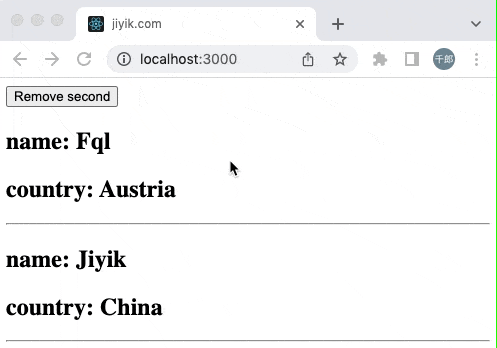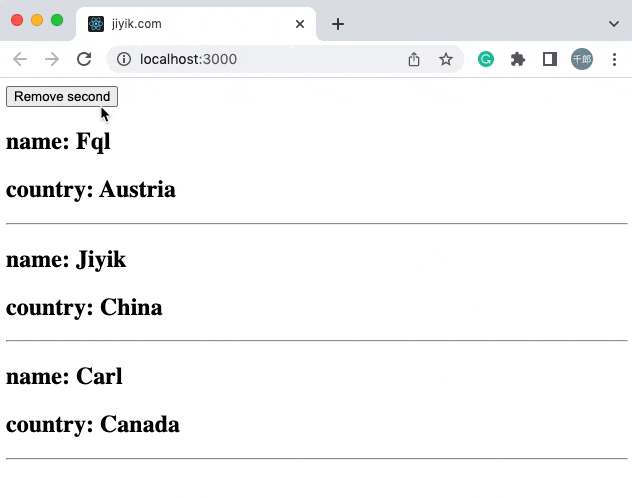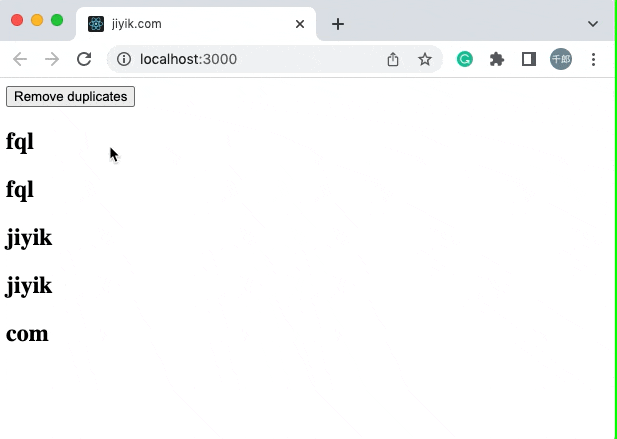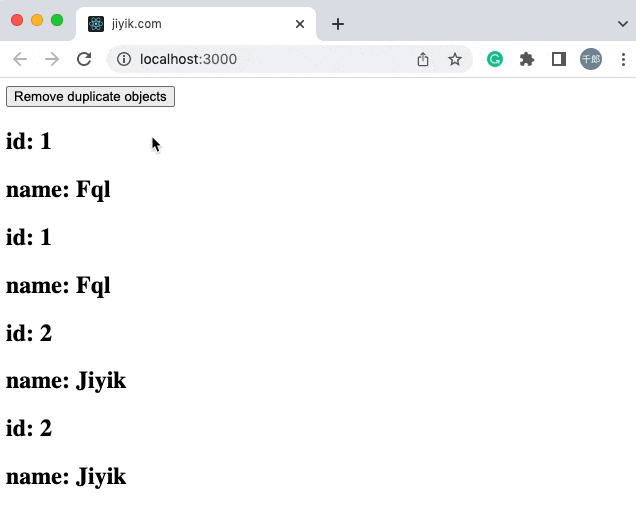目录
- 在 React 中从状态数组中删除一个元素:
- 永远不要在 React 中改变状态数组
- 根据多个条件从状态数组中删除元素
- 使用逻辑与 (&&) 运算符
- 使用逻辑或 (||) 运算符
- 使用两个运算符从状态数组中删除元素
- 从 React 中的 State 数组中删除重复项
- 从 React 中的状态数组中删除重复对象
在 React 中从状态数组中删除一个元素:
- 使用 filter() 方法迭代数组。
- 在每次迭代中,检查是否满足条件。
- 将状态设置为过滤器方法返回的新数组。
| import {useState} from 'react'; | |
| export default function App() { | |
| const initialState = [ | |
| {id:, name: 'Fql', country: 'Austria'}, | |
| {id:, name: 'Jiyik', country: 'China'}, | |
| ]; | |
| const [employees, setEmployees] = useState(initialState); | |
| const removeSecond = () => { | |
| setEmployees(current => | |
| current.filter(employee => { | |
| // 👇️ 删除等于 的对象 | |
| return employee.id !==; | |
| }), | |
| ); | |
| }; | |
| return ( | |
| <div> | |
| <button onClick={removeSecond}>Remove second</button> | |
| {employees.map(({id, name, country}) => { | |
| return ( | |
| <div key={id}> | |
| <h>name: {name}</h2> | |
| <h>country: {country}</h2> | |
| <hr /> | |
| </div> | |
| ); | |
| })} | |
| </div> | |
| ); | |
| } |

我们使用 useState 挂钩初始化了一个员工状态变量。
我们传递给 Array.filter 方法的函数会针对数组中的每个元素进行调用。
在每次迭代中,我们检查对象的 id 属性是否不等于 2 并返回结果。
| const initialState = [ | |
| {id:, name: 'Fql', country: 'Austria'}, | |
| {id:, name: 'Jiyik', country: 'China'}, | |
| ]; | |
| const filtered = initialState.filter(obj => { | |
| // 👇️ 为所有 id 不等于 的元素返回真 | |
| return obj.id !==; | |
| }); | |
| // 👇️ [{id:, name: 'Fql', country: 'Austria'}] | |
| console.log(filtered); |
filter 方法返回一个新数组,其中仅包含回调函数返回真值的元素。
如果从未满足条件,Array.filter 函数将返回一个空数组。
我们将一个函数传递给 setState,因为该函数可以保证以当前(最新)状态调用。
| const removeSecond = () => { | |
| // 👇️ current 是当前状态数组 | |
| setEmployees(current => | |
| current.filter(employee => { | |
| return employee.id !==; | |
| }), | |
| ); | |
| }; |
当使用前一个状态计算下一个状态时,将一个函数传递给 setState。
永远不要在 React 中改变状态数组
你不应该使用像 Array.pop() 或 Array.splice() 这样的函数来改变 React 中的状态数组。
| const removeSecond = () => { | |
| const index = employees.findIndex(emp => emp.id ===) | |
| // ⛔️ 不要这样做 | |
| employees.splice(index,) | |
| // ⛔️ 或者这样也不好 | |
| employees.pop() | |
| }; |
状态对象和数组是不可变的。 为了让 React 跟踪变化,我们需要将状态设置为一个新数组,而不是修改原始数组。
根据多个条件从状态数组中删除元素
如果我们需要根据多个条件从状态数组中删除一个对象,请使用逻辑与 && 或逻辑或 || 运算符。
使用逻辑与 (&&) 运算符
逻辑与 && 运算符检查多个条件是否为真。
| const initialState = [ | |
| {id:, name: 'Fql', country: 'Austria'}, | |
| {id:, name: 'Jiyik', country: 'China'}, | |
| {id:, name: 'Carl', country: 'Austria'}, | |
| ]; | |
| const [employees, setEmployees] = useState(initialState); | |
| const remove = () => { | |
| setEmployees(current => | |
| current.filter(employee => { | |
| return employee.id !== && employee.id !== 2; | |
| }), | |
| ); | |
| }; |
逻辑与 && 运算符仅在两个条件都为真时才计算为真。
仅当对象的 id 属性不等于 3 且不等于 2 时,回调函数才返回 true。
使用逻辑或 (||) 运算符
逻辑 OR || 运算符检查是否至少有一个条件的计算结果为真。
| const initialState = [ | |
| {id:, name: 'Fql', country: 'Austria'}, | |
| {id:, name: 'Jiyik', country: 'China'}, | |
| {id:, name: 'Carl', country: 'Austria'}, | |
| ]; | |
| const [employees, setEmployees] = useState(initialState); | |
| const remove = () => { | |
| setEmployees(current => | |
| current.filter(employee => { | |
| return employee.id !== && employee.id !== 2; | |
| }), | |
| ); | |
| }; |
两个条件中的任何一个都必须评估为要添加到新数组的元素的真值。
换句话说,如果对象的 name 属性等于 Fql 或 Carl,则该对象将被添加到新数组中。 所有其他对象都从数组中过滤掉。
使用两个运算符从状态数组中删除元素
如果我们必须检查多个复杂条件,也可以同时使用这两种运算符。
| const initialState = [ | |
| {id:, name: 'Fql', country: 'Austria'}, | |
| {id:, name: 'Jiyik', country: 'China'}, | |
| {id:, name: 'Carl', country: 'Austria'}, | |
| ]; | |
| const [employees, setEmployees] = useState(initialState); | |
| const remove = () => { | |
| setEmployees(current => | |
| current.filter(employee => { | |
| return employee.name === 'Fql' || employee.name === 'Carl'; | |
| }), | |
| ); | |
| }; |

括号中的代码使用逻辑 OR || 运算符来检查 employee 对象的 name 属性是否是两个值之一。
| const remove = () => { | |
| setEmployees(current => | |
| current.filter(employee => { | |
| return ( | |
| (employee.name === 'Fql' || | |
| employee.name === 'Carl') && | |
| employee.country === 'Canada' | |
| ); | |
| }), | |
| ); | |
| }; |
如果满足条件,则逻辑与 && 运算符检查对象的国家/地区属性是否等于加拿大。
括号中的表达式必须计算为真,右侧的条件必须计算为真才能将对象保存在状态数组中。
从 React 中的 State 数组中删除重复项
要从状态数组中删除重复项:
- 使用 useState() 挂钩将数组存储在状态中。
- 使用 Set() 构造函数从状态数组中删除重复项。
- 将状态数组更新为新值。
| import {useState} from 'react'; | |
| const App = () => { | |
| const words = ['fql', 'fql', 'jiyik', 'jiyik', 'com']; | |
| const [state, setState] = useState(words); | |
| const withoutDuplicates = [...new Set(words)]; | |
| // 👇️ ['fql', 'jiyik', 'com'] | |
| console.log(withoutDuplicates); | |
| const removeDuplicates = () => { | |
| setState(prevState => [...new Set(prevState)]); | |
| }; | |
| return ( | |
| <div> | |
| <button onClick={removeDuplicates}> | |
| Remove duplicates | |
| </button> | |
| {state.map((word, index) => { | |
| return ( | |
| <div key={index}> | |
| <h>{word}</h2> | |
| </div> | |
| ); | |
| })} | |
| </div> | |
| ); | |
| }; | |
| export default App; | |

我们传递给 Set 构造函数的参数是一个可迭代的——在我们的例子中是一个数组。
| const words = ['fql', 'fql', 'jiyik', 'jiyik', 'com']; | |
| // 👇️ {'fql', 'jiyik', 'com'} | |
| console.log(new Set(words)); | |
| const withoutDuplicates = [...words]; | |
| console.log(withoutDuplicates); // 👉️ ['fql', 'jiyik', 'com'] |
!> 数组的所有元素都添加到新创建的集合中。 但是,Set 对象只能存储唯一值,因此会自动删除所有重复项。
最后一步是使用 Spread 运算符 ... 将 Set 的值解包到一个新数组中。
从 React 中的状态数组中删除重复对象
要从 React 中的状态数组中删除重复对象:
- 创建一个将存储唯一对象 ID 的空数组。
- 使用 filter() 方法迭代状态数组。
- 检查唯一 ID 数组是否包含当前对象的 ID。
- 如果包含 ID,则将对象的 ID 添加到唯一 ID 数组并将对象添加到状态数组。
| import {useState} from 'react'; | |
| const App = () => { | |
| const employees = [ | |
| {id:, name: 'Fql'}, | |
| {id:, name: 'Fql'}, | |
| {id:, name: 'Jiyik'}, | |
| {id:, name: 'Jiyik'}, | |
| ]; | |
| const [state, setState] = useState(employees); | |
| const handleClick = () => { | |
| const uniqueIds = []; | |
| setState(currentState => { | |
| return currentState.filter(element => { | |
| const isDuplicate = uniqueIds.includes(element.id); | |
| if (!isDuplicate) { | |
| uniqueIds.push(element.id); | |
| return true; | |
| } | |
| return false; | |
| }); | |
| }); | |
| }; | |
| return ( | |
| <div> | |
| <button onClick={handleClick}> | |
| Remove duplicate objects | |
| </button> | |
| {state.map((employee, index) => { | |
| return ( | |
| <div key={index}> | |
| <h>id: {employee.id}</h2> | |
| <h>name: {employee.name}</h2> | |
| </div> | |
| ); | |
| })} | |
| </div> | |
| ); | |
| }; | |
| export default App; | |

我们传递给 Array.filter 方法的函数被数组中的每个元素(对象)调用。
| const employees = [ | |
| {id:, name: 'Fql'}, | |
| {id:, name: 'Fql'}, | |
| {id:, name: 'Jiyik'}, | |
| {id:, name: 'Jiyik'}, | |
| ]; | |
| const uniqueIds = []; | |
| const uniqueEmployees = employees.filter(element => { | |
| const isDuplicate = uniqueIds.includes(element.id); | |
| if (!isDuplicate) { | |
| uniqueIds.push(element.id); | |
| return true; | |
| } | |
| return false; | |
| }); | |
| console.log(uniqueEmployees); |
在每次迭代中,我们检查唯一 ID 数组是否包含当前对象的 ID。
如果是这样,我们有一个副本。
如果不包含它,我们需要将 ID 添加到唯一 ID 数组并从函数返回一个真值。
如果传递给该方法的函数返回真值,则过滤器方法只会向结果数组添加一个元素。
uniqueEmployees 数组不包含任何重复项。
我们使用 id 属性作为对象的标识符。 但是,在您的情况下,对象的标识符可能被称为其他名称。
本质上,我们的解决方案是:
- 仅将唯一 ID 添加到 uniqueIds 数组。
- 如果对象的 ID 不在 uniqueIds 数组中,则仅将对象添加到结果数组。